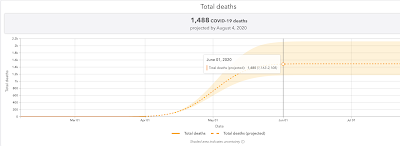Here's a morbid but interesting tool from the Institute for Health Metrics: a state-by-state calculator showing the predicted curves for medical resources and numbers of deaths from COVID-19, depending on mandated social distancing, as it varies across localities. The landing page starts with an overview of the whole U.S., but pick a state to see what the numbers predict for each, based on when things were or weren't closed down, plus how many beds, ICU beds, and ventilators are available in the hospitals.
I used it to make a comparison of Minnesota and Iowa's total predicted deaths. Remember, Iowa has about 62 percent of Minnesota's population, but otherwise the two states are relatively similar, as states go. Except that Minnesota's governor implemented a stay-at-home order on March 27 (though a fairly high number of people were doing it a week or two earlier) and schools were closed on March 18. Iowa's governor has done neither.


I know the two screen snapshots look the almost same, but click each one to read the numbers. Minnesota's predicted deaths flatten earlier (May 15) when they hit 919, while Iowa's continue until June 1 when they hit 1,480 (out of their population that is less than two-thirds Minnesota's size).
Aside from the lack of a stay-at-home order and school closures, Iowa also had an overall shortage of regular hospital beds and a deeper shortage of ICU beds. Minnesota had a surplus of regular hospital beds (because of flattening the curve) and a much smaller shortage of ICU beds, though it did still have a notable shortage.
Oh, and in case you were wondering: Iowa has more hospital beds and more ICU beds per capita than Minnesota: 1.36 per thousand vs. .87 for regular beds, .08 vs. .06 per thousand for ICU beds. So having fewer beds to start with is not the reason for this possible outcome.
I'm not sure if I will check back in two months to see how close to reality this grim prediction was.
__
This story from Friday's Star Tribune discusses the IHM's modeling, comparing it with the modeling Minnesota's Governor Walz used in issuing his stay-at-home order. It's a clear explainer of the various assumptions that underlie the different COVID-19 models and why they can diverge so widely, as the IHM model does from the death numbers Walz presented last week. I learned a lot from it. And I also learned that last week, before Walz's order, IHM was predicting Minnesota would have about 2,000 deaths by its flattening point, not the 919 it's predicting now.
Thursday, April 2, 2020
Grim Curves, Grim Realities?
Posted at
8:39 PM
![]()
![]()
Categories: Facts I Never Knew, Hell in a Handbasket
Subscribe to:
Post Comments (Atom)


1 comment:
Thanks for this post. I was wondering when our curve would start flattening. It seems I won't be going back to work anytime soon.
Post a Comment